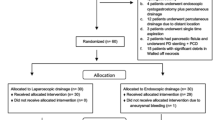Abstract
Background and Aims
Since redo surgery is associated with a high risk of morbidity and mortality after bariatric surgery in case of leakage, we sought to evaluate whether endoscopic drainage and debridement of collections following bariatric surgery is an efficient step-up approach to the management of these complications.
Methods
From 2007 to 2011, we retrospectively studied our cohort of nine cases treated by endoscopic drainage and debridement of abdominal abscesses secondary to postbariatric surgery leaks performed via the transluminal or percutaneous route.
Results
Three patients were treated by percutaneous endoscopic debridement of abscesses knowing that their leak was already closed by other endoscopic means and that their collection did not improve despite external drain in place. Six patients were treated by transluminal endoscopic drainage to perform necrosectomy as a first-line option or after failure of improvement after endoscopic treatment. The number of sessions required ranged from 1 to 3. Most severe patients had rapid improvement of their hemodynamic and respiratory conditions. In eight of the nine patients, we were able to close the fistula by stent, fistula plugs, or a macroclip. Resolution of collections was seen in seven out of nine patients, but two required further surgery.
Conclusions
Endoscopic necrosectomy via the transluminal or percutaneous route is a feasible option in postbariatric surgery patients with necrotic abscesses not adequately managed by the classical combination of percutaneous drainage and stenting. Further wide-scale studies are needed to compare this non-surgical method with surgical necrosectomy in postbariatric surgery patients.






Similar content being viewed by others
Abbreviations
- cSEMS:
-
Covered self-expandable metallic stent
- LSG:
-
Laparoscopic sleeve gastrectomy
- RYGBP:
-
Roux-en-Y gastric bypass
References
Marshall JS, Srivastava A, Gupta SK, et al. Roux-en-Y gastric bypass leak complications. Arch Surg. 2003;138:520–3.
Fernandez Jr AZ, DeMaria EJ, Tichansky DS, et al. Experience with over 3,000 open and laparoscopic bariatric procedures: multivariate analysis of factors related to leak and resultant mortality. Surg Endosc. 2004;18:193–7.
Gagner M, Deitel M, Kalberer TL, et al. The second International Consensus Summit for Sleeve Gastrectomy, March 19–21, 2009. Surg Obes Relat Dis. 2009;5:476–85.
Kasalicky M, Michalsky D, Housova J, et al. Laparoscopic sleeve gastrectomy without an over-sewing of the staple line. Obes Surg. 2008;18:1257–62.
Gonzalez R, Sarr MG, Smith CD, et al. Diagnosis and contemporary management of anastomotic leaks after gastric bypass for obesity. J Am Coll Surg. 2007;204:47–55.
Papavramidis T, Kotzampassi K, Kotidis E, et al. Endoscopic fibrin sealing of gastrocutaneous fistulas after sleeve gastrectomy and biliopancreatic diversion with duodenal switch. J Gastroenterol Hepatol. 2008;23:1802–5.
Eisendrath P, Cremer M, Himpens J, et al. Endotherapy including temporary stenting of fistulas of the upper gastrointestinal tract after laparoscopic bariatric surgery. Endoscopy. 2007;39:625–30.
Swinnen J, Eisendrath P, Rigaux J, et al. Self-expandable metal stents for the treatment of benign upper GI leaks and perforations. Gastrointest Endosc. 2011;73:890–9.
Baron TH, Harewood GC, Morgan DE, et al. Outcome differences after endoscopic drainage of pancreatic necrosis, acute pancreatic pseudocysts, and chronic pancreatic pseudocysts. Gastrointest Endosc. 2002;56:7–17.
Hookey LC, Debroux S, Delhaye M, et al. Endoscopic drainage of pancreatic-fluid collections in 116 patients: a comparison of etiologies, drainage techniques, and outcomes. Gastrointest Endosc. 2006;63:635–43.
Seewald S, Groth S, Omar S, et al. Aggressive endoscopic therapy for pancreatic necrosis and pancreatic abscess: a new safe and effective treatment algorithm (videos). Gastrointest Endosc. 2005;62:92–100.
Voermans RP, Veldkamp MC, Rauws EA, et al. Endoscopic transmural debridement of symptomatic organized pancreatic necrosis (with videos). Gastrointest Endosc. 2007;66:909–16.
Seifert H, Biermer M, Schmitt W, et al. Transluminal endoscopic necrosectomy after acute pancreatitis: a multicenter study with long-term follow-up (the GEPARD study). Gut. 2009;58:1260–6.
Gardner TB, Chahal P, Papachristou GI, et al. A comparison of direct endoscopic necrosectomy with transmural endoscopic drainage for the treatment of walled off pancreatic necrosis. Gastrointest Endosc. 2009;69:1085Y1094.
Mathew A, Biswas A, Meitz KP. Endoscopic necrosectomy as primary treatment for infected peripancreatic fluid collections (with video). Gastrointest Endosc. 2008;68:776–82.
Van Santvoort HC, Besselink MG, Bakker OJ, et al. Dutch Pancreatitis Study Group A step-up approach or open necrosectomy for necrotizing pancreatitis. N Engl J Med. 2010;362(16):1491–502.
Bège T, Emungania O, Vitton, et al. An endoscopic strategy for the management of anastomotic complications from bariatric surgery: a prospective study. Gastrointest Endosc. 2011;73:238–44.
Baron TH, Wong KS. Percutaneous assisted transprosthetic endoscopic therapy (PATENT): expanding gut access to infinity and beyond! (with video). Gastrointest Endosc. 2012;76:641–4.
Papavramidis TS, Mantzoukis K, Michalopoulos N. Confronting gastrocutaneous fistulas. Ann Gastroenterol. 2011;24:16–9.
Mercky P, Gonzalez JM, Bonin EA, et al. Usefulness of over-the-scope clipping system for closing digestive fistulas. Dig Endosc. 2014;27:18–24.
Toussaint E, Eisendrath P, Kwan V, et al. Endoscopic treatment of postoperative enterocutaneous fistulas after bariatric surgery with the use of a fistula plug: report of five cases. Endoscopy. 2009;41:560–3.
Acknowledgments
There is no grant in this study.
Conflict of Interest
The authors declare that they have no conflict of interest.
Ethical Approval
For this type of study formal consent is not required.
Informed Consent
Informed consent is not required in this study.
Author information
Authors and Affiliations
Corresponding author
Rights and permissions
About this article
Cite this article
Lemmers, A., Tan, D.M., Ibrahim, M. et al. Transluminal or Percutaneous Endoscopic Drainage and Debridement of Abscesses After Bariatric Surgery: a Case Series. OBES SURG 25, 2190–2199 (2015). https://doi.org/10.1007/s11695-015-1854-9
Published:
Issue Date:
DOI: https://doi.org/10.1007/s11695-015-1854-9




